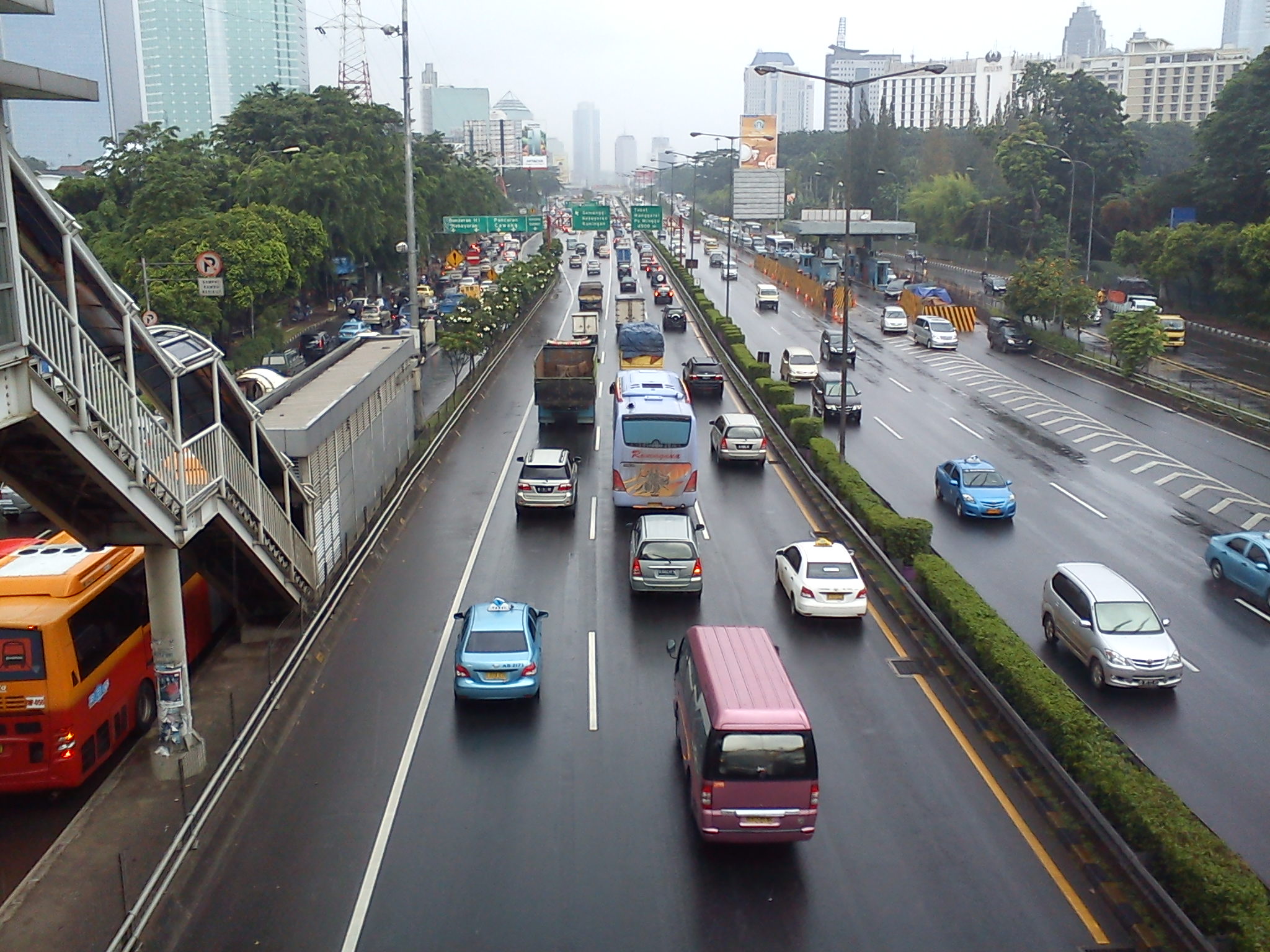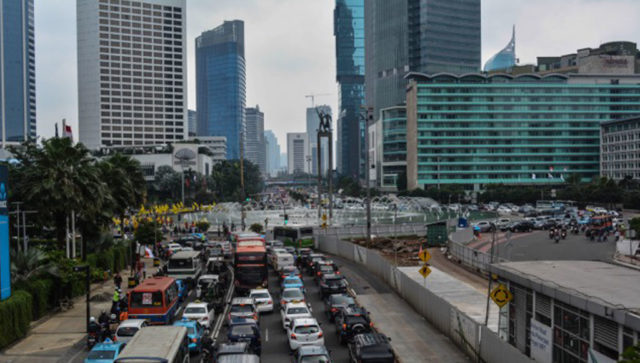
Governor Ahok’s Policy to Solve Jakarta’s Traffic Jams
April 30, 2015 — Blog
Jakarta is the capital of Indonesia with a total area of 661.52 km², home to 12.4 million people during daytime and 9,9 million at night. This number is almost four times that of other major cities in Indonesia such as Bandung, Surabaya, and Medan. The city of Jakarta is surrounded by other, smaller cities, such as Bogor, Depok, Tangerang, and Bekasi, which together form one sprawling urban area. The metropolitan Jakarta area holds 28 million people.

Due to an inadequate public transport system, citizens commonly opt to travel in private vehicles.
As a center for business, politics and culture, Jakarta is home to headquarters of state-owned enterprises, private companies, governmental offices and foreign embassies. This of course contributes to high levels of activity and traffic. Due to an inadequate public transport system, citizens commonly opt to travel in private vehicles. The number of commuters from Bogor, Depok, Tangerang and Bekasi who are doing their activities in Jakarta, based on Center of Statistics Agency (Badan Pusat Statistik, BPS) Jakarta 2014 data is 1,382,296 people.
The traffic problem in Jakarta, unsolved by previous governments, has led to its ranking as the city with the worst traffic in the world, according to Castrol’s Magnatec Stop-Start index.
According to Bambang Susantono, Chief of the Indonesian Transportation Community (Masyarakat Transportasi Indonesia, MTI), the ongoing traffic problem in Jakarta causes Rp 8,3 trillion (USD 640,000,000) of loss per year, referring to the Study on Integrated Transportation Master Plan for Jabodetabek (SITRAMP 2004). This calculation includes three aspects as the consequences of traffic jams, namely fuel loss because of the vehicle’s operating cost of Rp. 3 trillion, loss caused by wasted time of Rp. 2,5 trillion (USD 192,975,000), and the impact of air pollution to health, estimated at Rp. 2,8 trillion (USD 216,132,000).
Compared to the growth in the number of vehicles, the expansion of roads cannot catch up.
Currently, the number of vehicles in Jakarta has reached 6.5 million units, of which 6.4 million units (98.6 per cent) includes private vehicles, and of which 88,477 units (1.4 per cent) includes public transportation. Moreover, vehicle use is growing by 11 per cent each year. Meanwhile, the length of existing roads is 7.65 km, spanning a total area of 40.1 km2 or 6,2% of the DKI Jakarta area, with a growth of only 0.01 per cent per year. Compared to the growth in the number of vehicles, the expansion of roads cannot catch up. It is therefore logical that almost every road is clogged with traffic. Of course, the situation will only worsen.
To combat Jakarta’s traffic jams, the Governor of Jakarta, Basuki Tjahaja Purnama – commonly known as “Ahok” – has begun to implement several short and long-term policies since coming to office in October 2014. One of his long-term plans includes establishing a new Mass Rapid Transport (MRT) system. Construction has already begun and will be completed by 2018. This MRT line will serve people with Kota-Lebak Bulus route. This is a type of rail-based MRT Heavy Rail Transit and will be integrated with other mass transportation such as bus, Transjakarta and train. MRT in Jakarta is expected to reduce the number of motor vehicle users by 25,500 each day.
One could point out that Jakarta has been late in beginning its MRT project. However, as the saying goes, better late than never. Other major cities like Hong Kong have also faced several bureaucratic issues when launching their MRT projects. This project is expected to be a good start for subsequent traffic alleviation programs in Jakarta.
Furthermore, the establishment of a Light Rail Transit (LRT) system is in the bidding process for Jakarta. If all goes to plan LRT is expected to be in operation by 2018, simultaneously with MRT. LRT is expected to be able to transport 360,000 passengers per day.
The Metro LRT will serve seven routes in Jakarta stretching to a total length of 21.6 km. Ahok said that besides Jakarta, Commuter LRT will also be planned to extend from Jakarta to Bekasi, West Java. The targeted route is from the Northern coast of Java, City of Tangerang – Soekarno Hatta Airport-Ancol – PRJ Kemayoran-Pulogadung-Bekasi.
Ahok is also planning to build subsidized housing and apartments in the city center. The establishment of such apartments and subsidized housing will be intended for people working in offices or holding businesses around traditional markets. “This is also done to overcome traffic jams, because these markets are located in the middle of the city,” said Ahok.
Several new policies have already been introduced, such as the restriction of motorcycles.
The Government of Jakarta must also move quickly and produce effective short-term policies. Several new policies have already been introduced, such as the restriction of motorcycles to travel along Thamrin road, the main and busiest road in Jakarta besides Sudirman road. Ahok believes that his policy is successful in reducing traffic in Thamrin, and forcing motorcyclists to use bus.
On a separate occasion, the Head of Jakarta’s Transportation Office, Benjamin Bukit, announced that the plan had been for motorcycle restriction to be expanded even further by January 2015. However, to date this regulation is still being evaluated. Bukit stated that implementation will occur when the requirements are fulfilled. These requirements include a strong legal foundation, availability of alternative roads and availability of parking locations. For the time being, the Transportation Agency will note buildings that can be used for parking.
In addition to motorcyclists, car drivers will also have more incentives to use public transport. Car drivers travelling through certain main roads will be charged a fee, or Electronic Road Pricing (ERP). Every car passing through will be charged Rp. 30.000 (USD 2.70) each time. ERP will be implemented to replace the 3 in 1 system, which is considered ineffective. The Local Government of Jakarta expects to apply this system by the end of 2015.
Another policy taken related to traffic alleviation is traffic management. The Deputy to the Governor in the Industrial, Trade, and Transportation Division of the Provincial Government of Jakarta, Sutanto Soehodo, said that the city will conduct traffic management by doing three things: improving road infrastructure, adding roads with the development of tolls and flyovers, and boosting public transportation. Sutanto added that efforts to resolve traffic jams will continue to be made in the short term, medium term and long term plans.
Many solutions are being offered to manage traffic in Jakarta. Previously, the former Vice President of the Republic of Indonesia, Boediono, offered 17 points on how to overcome traffic jams in 2010. The MRT project itself was first planned 27 years ago, but its realization has only come about during the current Governor’s leadership. The traffic in Jakarta is worsening and this must be solved immediately by the Governor of Jakarta, with the support of all stakeholders, including from local people’s representative assembly and the national government.
Transformasi is a partner of the New Cities Summit in Jakarta. Read another blog by the Transformasi team here.